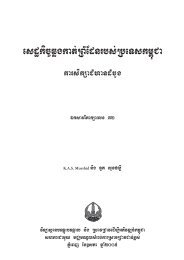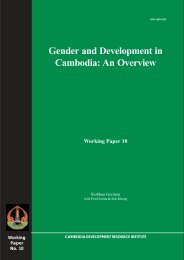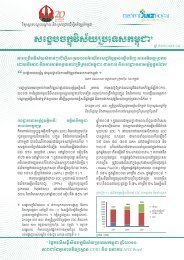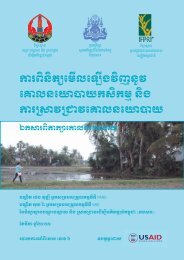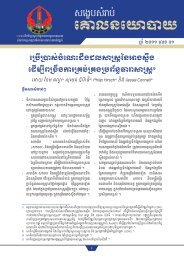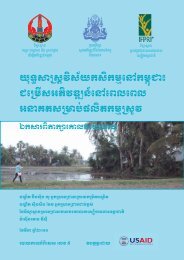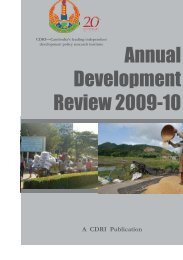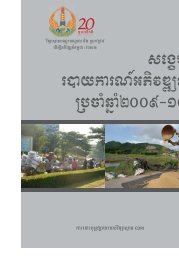Foreign Investment in Agriculture in Cambodia CDRI Working Paper ...
Foreign Investment in Agriculture in Cambodia CDRI Working Paper ...
Foreign Investment in Agriculture in Cambodia CDRI Working Paper ...
Create successful ePaper yourself
Turn your PDF publications into a flip-book with our unique Google optimized e-Paper software.
•<br />
•<br />
4.1. Fisheries<br />
First and second prov<strong>in</strong>cial vice governors as vice-chairs<br />
Chiefs of departments of each relevant m<strong>in</strong>istry, namely the m<strong>in</strong>istries of Economy<br />
and F<strong>in</strong>ance; Commerce; Industry, M<strong>in</strong>es and Energy; Public Works and Transport;<br />
Environment; Land Management, Urban Plann<strong>in</strong>g and Construction; <strong>Agriculture</strong>,<br />
Forestry and Fisheries; Plann<strong>in</strong>g; Water Resources and Meteorology; Tourism; Post<br />
and Telecommunications; and the Chamber of Commerce.<br />
Fish is the second staple food after rice <strong>in</strong> <strong>Cambodia</strong>. It plays a crucial role <strong>in</strong> people’s<br />
livelihoods and is a major source of <strong>in</strong>come and food security <strong>in</strong> the country. There are two<br />
levels of fisheries management <strong>in</strong> <strong>Cambodia</strong>, namely central and local governments. At central<br />
level, the Department of Fisheries of MAFF is <strong>in</strong> charge of policy formulation and the conduct<br />
of research and <strong>in</strong>spection, while at local level, the sector is under the control of the Prov<strong>in</strong>cial-<br />
Urban Fishery Authorities which have the power to ensure compliance with the law <strong>in</strong> the areas<br />
under their jurisdiction.<br />
Several laws govern the sector, <strong>in</strong>clud<strong>in</strong>g the Fisheries Management and Adm<strong>in</strong>istration<br />
Law (1987), the proclamation on competent authorities <strong>in</strong> issu<strong>in</strong>g permission to fish <strong>in</strong> open<br />
water, aquaculture, fish process<strong>in</strong>g and special permissions (1989), and the Sub-law on<br />
Transportation of Fishery Products (1988). It should be noted that <strong>Cambodia</strong>’s master plan for<br />
fisheries 2001-2011 was developed <strong>in</strong> 2001, while the Fisheries Law promulgated <strong>in</strong> 2006 was<br />
to better manage the sector. Despite the <strong>in</strong>troduction of necessary regulations, illegal fish<strong>in</strong>g<br />
and habitat destruction along the Mekong River and <strong>in</strong> the Tonle Sap Lake cont<strong>in</strong>ue more<br />
or less unabated, and conflict over fish<strong>in</strong>g rights between communities and politically and<br />
economically more powerful commercial fish<strong>in</strong>g lot owners is common (FAO 2011: 6, 10).<br />
Law enforcement is observed to be ad hoc or case-by-case. For <strong>in</strong>stance, the recent tough<br />
action taken by the prime m<strong>in</strong>ister on 1 July 2011 order<strong>in</strong>g the M<strong>in</strong>ister of <strong>Agriculture</strong>, Forestry<br />
and Fisheries to remove fishery chiefs <strong>in</strong> five prov<strong>in</strong>ces around the Tonle Sap Lake on suspicion<br />
of fishery <strong>in</strong>fr<strong>in</strong>gements by irregularly sell<strong>in</strong>g fish<strong>in</strong>g lots, is part of the government’s effort<br />
towards fishery reform (Yang 2011).<br />
On the regulation of <strong>in</strong>vestment, no specific policy has been set; however, <strong>in</strong>vestment<br />
<strong>in</strong>centives, i.e. exemption of taxes and duties, are set out <strong>in</strong> <strong>Cambodia</strong>’s <strong>Investment</strong> law. Those<br />
<strong>in</strong>vestments <strong>in</strong>clude fish hatcheries of more than 2 ha and shrimp farm<strong>in</strong>g and other aquaculture<br />
production greater than 10 ha. The sector’s <strong>in</strong>vestment procedures are similar to those<br />
outl<strong>in</strong>ed above.<br />
In order to develop the sub-sector, the government has distributed mar<strong>in</strong>e and freshwater<br />
fish<strong>in</strong>g lots to the people for both consumption and commercial purposes, with the aim of<br />
facilitat<strong>in</strong>g fish<strong>in</strong>g operations, susta<strong>in</strong><strong>in</strong>g fisheries stock and preserv<strong>in</strong>g natural resources.<br />
Further, given the <strong>in</strong>creas<strong>in</strong>g demand for fish due to population growth, the government has<br />
been encourag<strong>in</strong>g a shift <strong>in</strong> focus from natural catches to aquaculture.<br />
To better manage fisheries resources, the government is establish<strong>in</strong>g an effective price<br />
mechanism by ensur<strong>in</strong>g proper demarcation of fish<strong>in</strong>g lots and mak<strong>in</strong>g the process of bidd<strong>in</strong>g<br />
for a fish<strong>in</strong>g lot more transparent. This will help <strong>in</strong>crease state revenue from fisheries. Tough<br />
measures are be<strong>in</strong>g taken to crackdown on illegal fish<strong>in</strong>g activities and encroachment of<br />
flooded forests. Fish farmers and communities are given technical assistance, credit and market<br />
facilitation to improve their capacity and <strong>in</strong>crease their revenue. To <strong>in</strong>crease competitiveness and<br />
24 <strong>Foreign</strong> <strong>Investment</strong> <strong>in</strong> <strong>Agriculture</strong> <strong>in</strong> <strong>Cambodia</strong>



